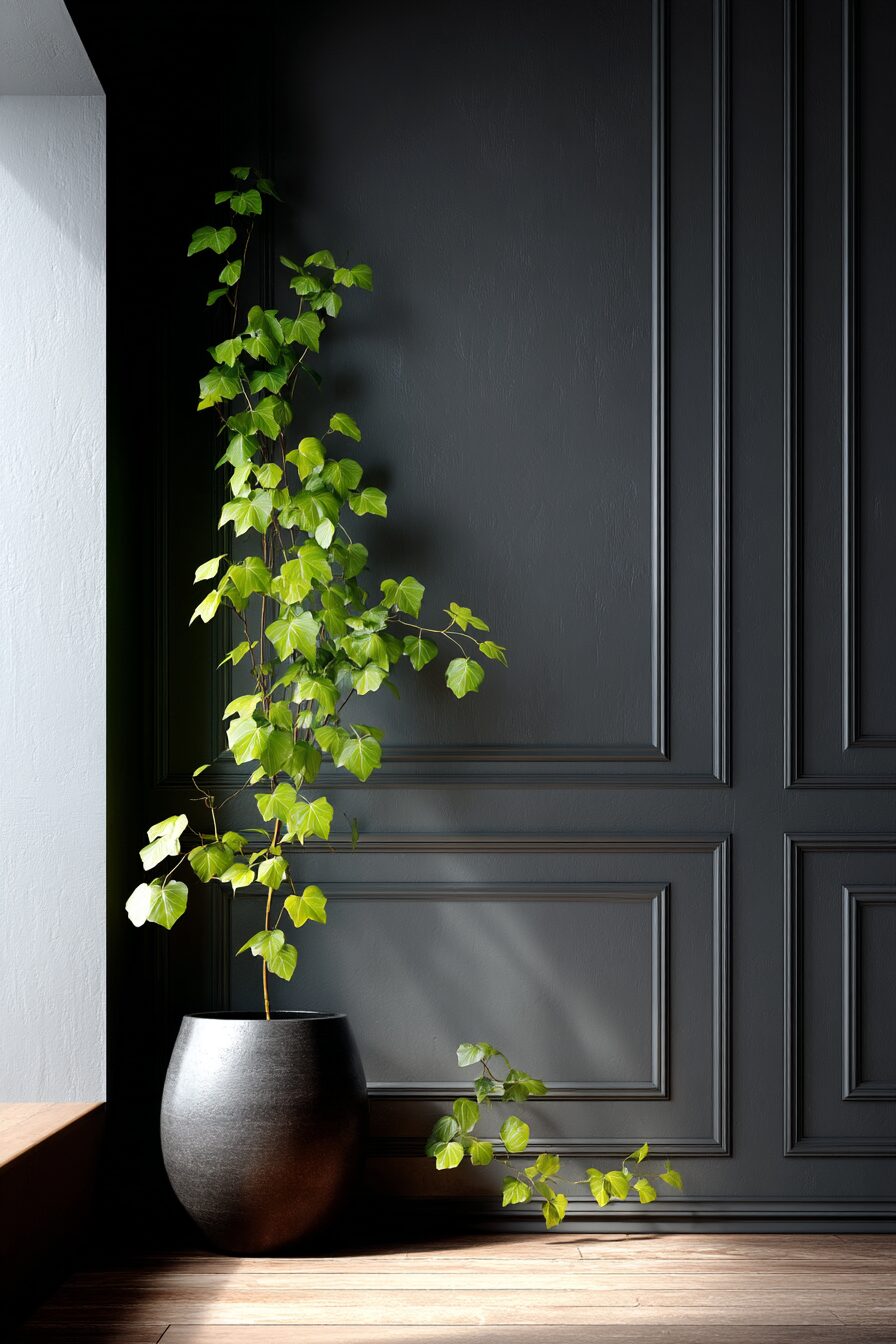Ever stared at that gloomy corner of your home and thought it was a plant-free zone?
Think again, because some amazing greenery actually prefers those shadowy spots!
Dark rooms don’t have to be lifeless spaces devoid of nature’s touch.
With the right selection of low-light loving plants, you can transform even the dimmest areas into lush, vibrant spaces that breathe life into your home.
Snake Plant
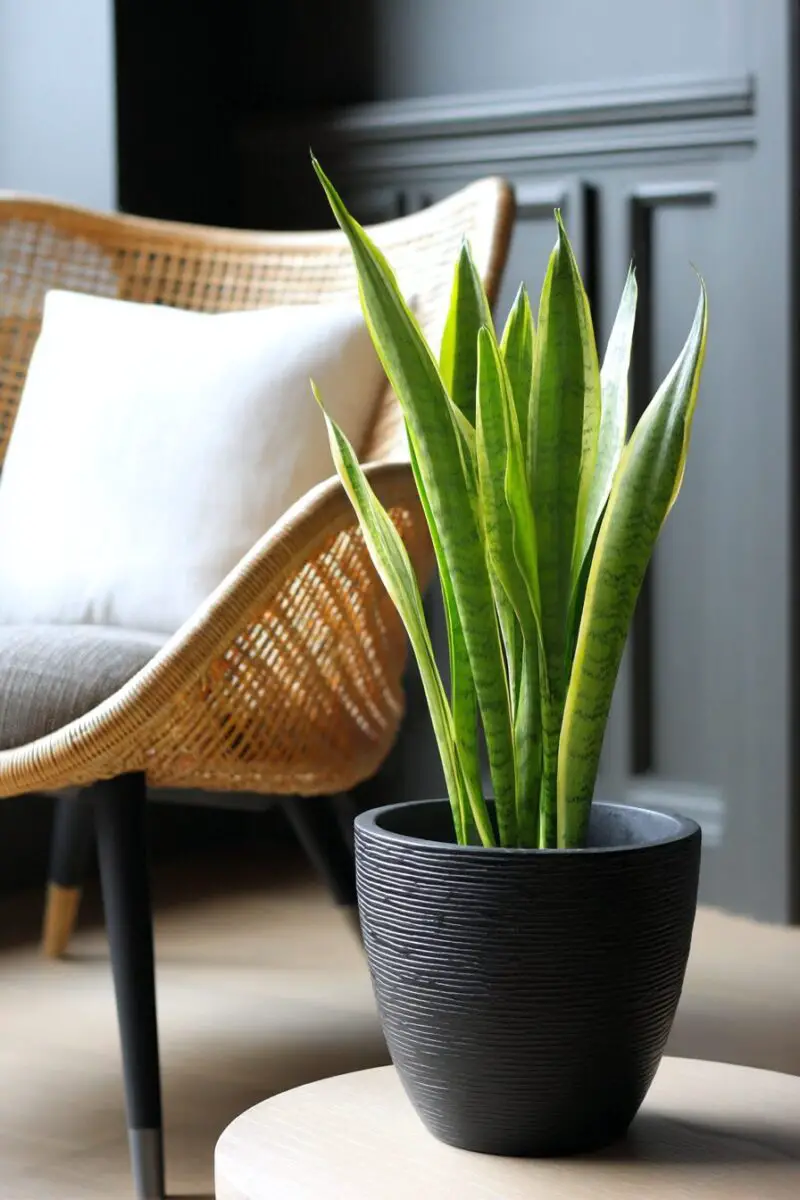
Snake plants top every dark room plant list for good reason—they’re practically immortal.
These striking vertical beauties can survive in conditions that would kill most other houseplants.
Their sword-like leaves add architectural interest to any dark corner without demanding much in return.
Native to West Africa, snake plants have evolved to thrive in harsh conditions with minimal light.
You could literally keep these in a windowless bathroom and they’ll still look amazing.
Watering these tough plants is ridiculously simple—once every 2-3 weeks is plenty, and even less in winter.
Overwatering is the only real way to kill a snake plant, so when in doubt, leave it alone.
These plants purify your air by removing toxins like formaldehyde and benzene, continuing this process even at night when most plants take a break.
The NASA Clean Air Study ranked snake plants among the top air-purifying plants, making them perfect for bedrooms and rarely-used spaces.
Their striking upright form saves precious floor space in small apartments or crowded rooms.
Available in varieties with different patterns and edges, from the classic green-bordered yellow to the compact “Bird’s Nest” type, there’s a snake plant for every style preference.
Snake plants rarely outgrow their containers, making them low-maintenance for years.
Some varieties like Sansevieria cylindrica (Cylindrical Snake Plant) offer unique cylindrical leaves that look like green spikes emerging from the pot.
These plants are considered symbols of good luck in some cultures, said to protect homes from negative energy.
If you’re a serial plant killer with a dark apartment, the snake plant might finally break your curse.
Snake plants are pet-friendly, making them ideal for dark rooms in homes with curious four-legged friends.
Their strong vertical lines create visual interest and can make low ceilings appear higher.
With minimal care, a snake plant can live for decades, becoming a long-term companion in your home.
Some snake plants will occasionally surprise you with delicate, fragrant white flowers on tall stalks.
For maximum impact, place your snake plant in a sleek, tall pot that complements its architectural form.
ZZ Plant
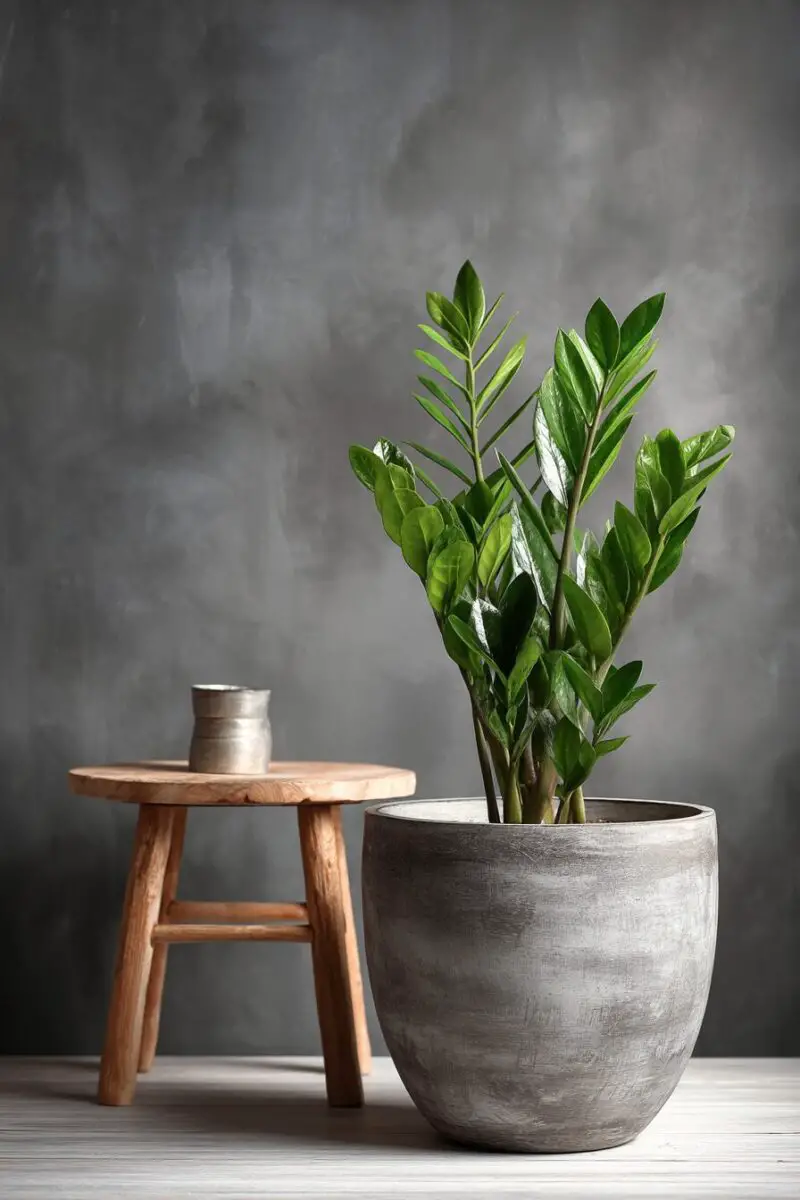
The ZZ plant has gained a cult following among plant enthusiasts for its remarkable ability to thrive in challenging conditions.
This glossy, dark green beauty can survive in lighting conditions that would send other plants to an early grave.
Native to Eastern Africa, the ZZ plant evolved to endure long periods of drought in naturally shady environments.
The plant’s underground rhizomes store water, allowing it to withstand neglect for weeks or even months.
ZZ plants feature attractive, pinnate leaves that grow in a graceful arching pattern, resembling feathers.
Their shiny, waxy leaves reflect what little light exists in dark rooms, creating a subtle glow in shadowy corners.
You’ll only need to water a ZZ plant when the soil is completely dry—usually every 2-3 weeks, or even less frequently in darker spaces.
These plants actually prefer to be left alone rather than receiving too much attention or water.
ZZ plants aren’t just pretty—they’re powerhouse air purifiers that remove toxins like xylene, toluene, and benzene from your indoor environment.
Their slow growth rate means they won’t quickly outgrow their space, making them perfect for small dark rooms.
The plant’s thick, potato-like rhizomes act as water storage units, explaining why ZZs can survive extended periods without care.
Despite their exotic appearance, ZZ plants are surprisingly tough and can bounce back from severe neglect.
Some plant enthusiasts jokingly call them “zombie plants” because they can look nearly dead and then spring back to life with minimal intervention.
ZZ plants come in different varieties, including the standard green and the rare “Raven” ZZ with dramatic near-black foliage that makes a striking statement in dark rooms.
These plants have a natural resistance to pests and diseases, making them even more low-maintenance.
A ZZ plant can beautifully anchor a dark hallway, bathroom, or office space where other plants would struggle.
The symmetrical growth pattern of ZZ plants makes them naturally attractive without needing much styling or pruning.
They’re perfect plants for frequent travelers or forgetful waterers who can’t maintain regular plant care schedules.
ZZ plants can live for many years with minimal care, developing a fuller, more impressive appearance over time.
While toxic if ingested in large quantities, keeping ZZ plants away from pets and children makes them safe additions to your home.
Design Your Dream Room in Minutes!
🏡 Start Creating FREE →Pothos
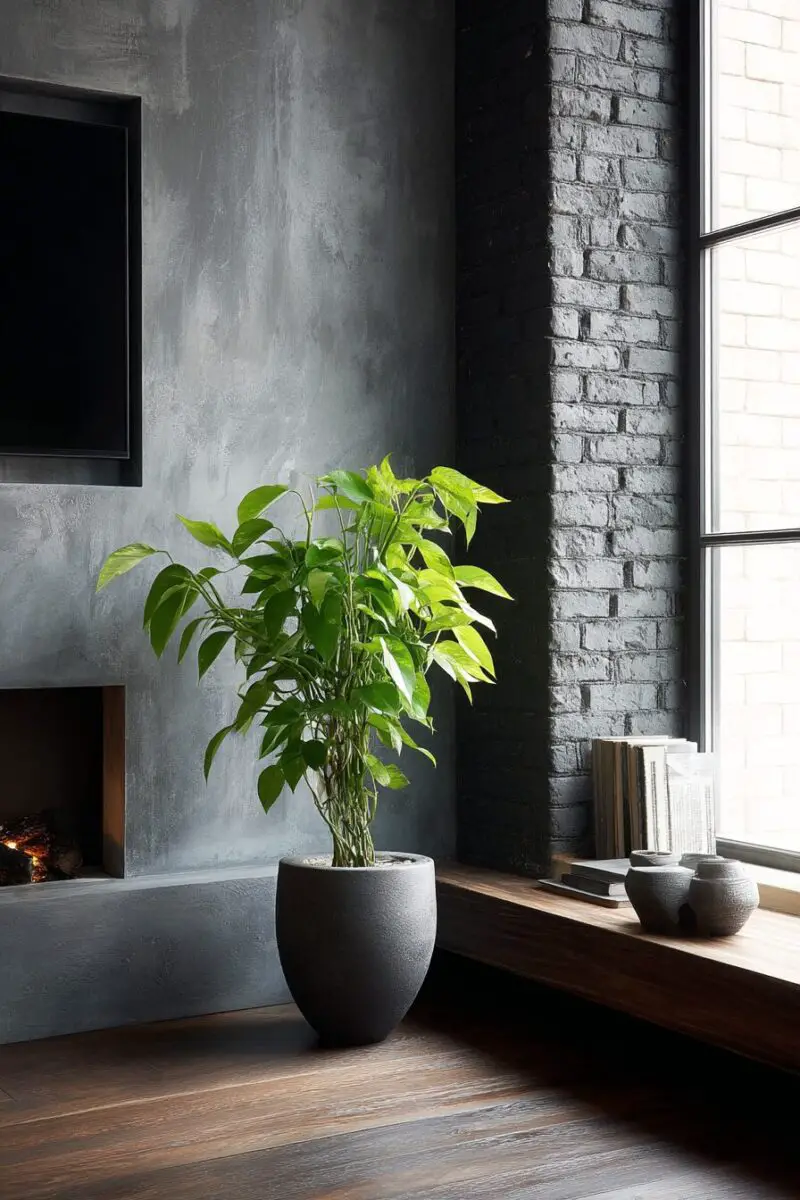
Pothos earns its nickname “devil’s ivy” because it’s almost impossibly hard to kill, even in the darkest conditions.
This trailing beauty can transform any dull shelf or dark corner into a cascading display of heart-shaped leaves.
Available in varieties ranging from solid green to variegated patterns of white, yellow, or silver, pothos offers options for every aesthetic preference.
The plant’s vining nature makes it perfect for elevating your dark room’s style with minimal effort.
Pothos vines can grow several feet long, creating dramatic curtains of foliage that soften harsh architectural elements in low-light spaces.
While pothos prefers moderate light, it adapts remarkably well to low-light conditions, simply growing a bit slower and producing leaves with less variegation.
You’ll only need to water your pothos when the top inch of soil feels dry to the touch, typically every 7-10 days.
These plants communicate clearly when thirsty—their leaves will begin to droop slightly, signaling it’s time for a drink.
Pothos plants naturally climb trees in their native Southeast Asian habitats, but in your home, they’ll happily trail from shelves or climb moss poles.
The NASA Clean Air Study found pothos effective at removing common household toxins like formaldehyde, benzene, and carbon monoxide.
Propagating pothos is incredibly simple—just snip a section of vine with a node, place it in water, and watch roots develop within days.
This easy propagation makes pothos the perfect plant to multiply for free, allowing you to fill multiple dark corners in your home.
Pothos plants can survive in water alone, making them fantastic additions to dark bathrooms where they can thrive in decorative vases.
Their adaptability extends to temperature as well—pothos tolerates standard indoor temperatures between 65-85°F without complaint.
Unlike many houseplants, pothos rarely attracts pests, making maintenance even simpler in challenging light conditions.
The plant’s glossy leaves naturally repel dust and stay looking fresh with minimal care.
Pothos earned the nickname “cubicle plant” because of its ability to thrive under office fluorescent lights without access to natural sunlight.
Different pothos varieties offer distinct aesthetics: Golden Pothos features yellow variegation, Marble Queen showcases creamy white patterns, and Neon Pothos brings a vibrant chartreuse color to dark corners.
You can train pothos vines to grow along walls or around door frames using small hooks or plant tape for a living decor element in dark hallways.
Pothos plants continue growing for years, becoming more impressive as their vines lengthen and cascade.
Cast Iron Plant
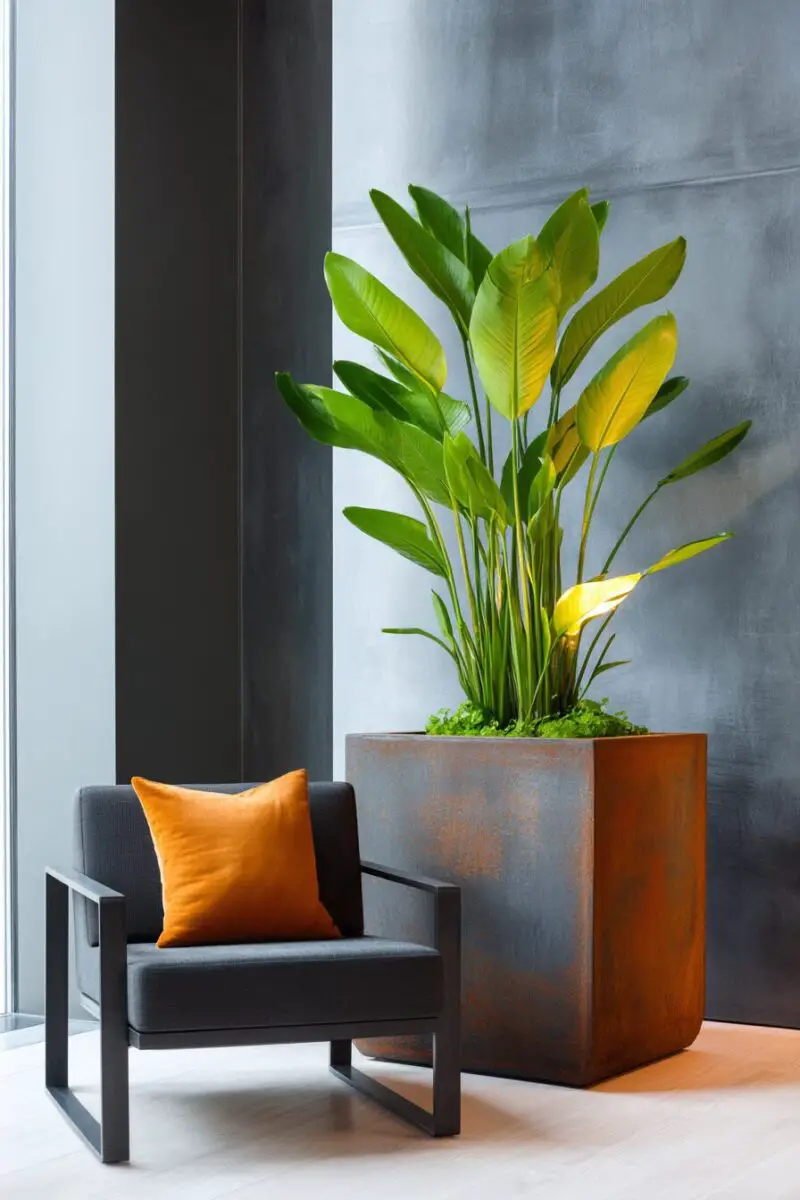
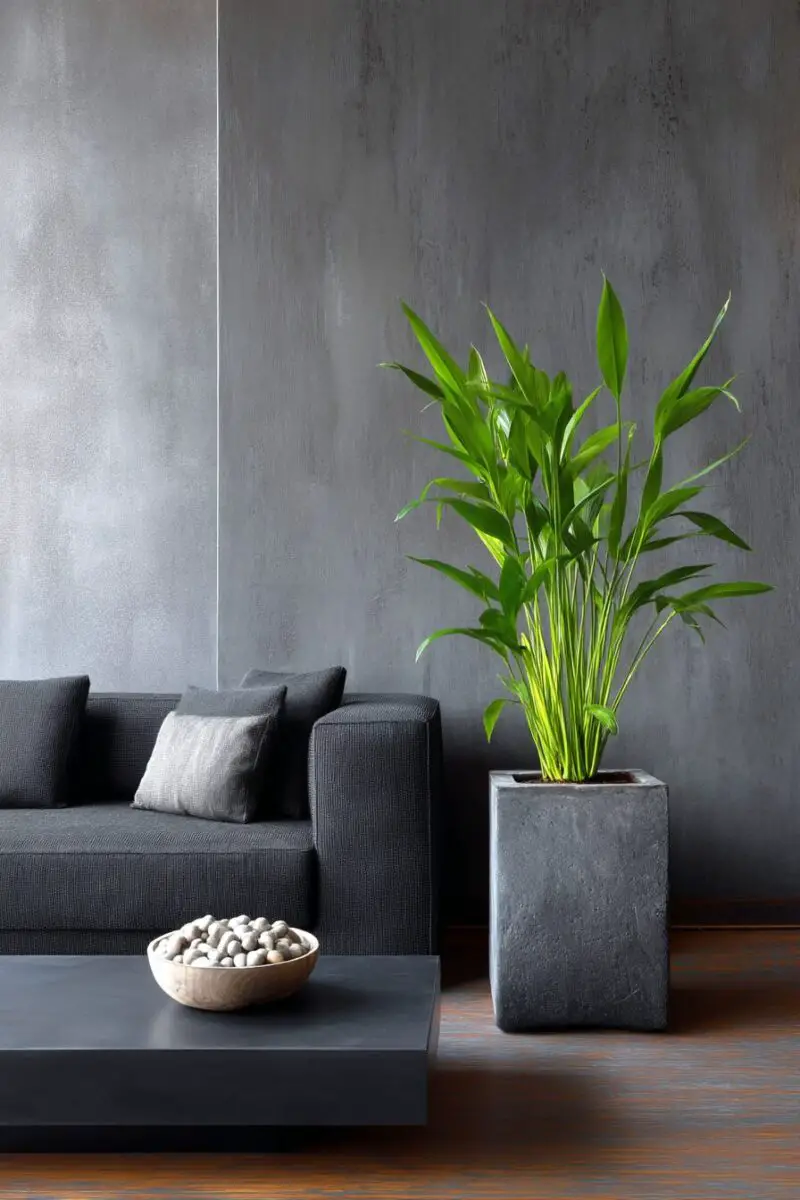
The Cast Iron Plant earned its name for an excellent reason—it’s practically indestructible and can handle conditions that would destroy most other houseplants.
This sturdy, old-fashioned plant has been a favorite since Victorian times when it thrived despite dim gaslight and coal dust in poorly ventilated homes.
Cast Iron Plants feature broad, arching dark green leaves that emerge directly from the soil, creating a fountain-like display that adds texture to dark corners.
Native to the forest floors of Japan and Taiwan, these plants evolved to thrive in deep shade beneath dense tree canopies.
You can literally place a Cast Iron Plant in a windowless room with only occasional artificial light, and it will continue to look attractive for years.
These plants grow extremely slowly, often taking months to produce new leaves, which means they won’t quickly outgrow their spot in your dark room.
Watering a Cast Iron Plant is remarkably simple—once every 2-3 weeks is typically sufficient, allowing the soil to dry out completely between waterings.
Their thick, leathery leaves resist pests, diseases, and drought, making them truly worthy of their “iron” nickname.
These plants have an impressive lifespan, often becoming family heirlooms passed down through generations.
The occasional appearance of small, unusual purple flowers near the soil level is a rare but delightful surprise for Cast Iron Plant owners.
Unlike many houseplants, Cast Iron Plants don’t mind dry air, making them perfect for air-conditioned or heated rooms that lack humidity.
Their deep green color provides a perfect backdrop for brighter decorative elements in dark rooms.
Cast Iron Plants resist yellowing or browning even in challenging conditions, maintaining their attractive appearance with minimal effort.
These plants can survive outright neglect for weeks or even months, bouncing back with minimal care when you finally remember them.
The variegated variety, with cream-striped leaves, adds extra visual interest to dark corners while still maintaining the plant’s legendary toughness.
Cast Iron Plants grow about 2-3 feet tall at maturity, making them perfect for filling empty floor space in dark rooms without overwhelming the area.
Dusting the broad leaves occasionally will help them photosynthesize more efficiently in low light and maintain their attractive appearance.
These plants are completely non-toxic to pets and children, making them safe additions to family homes with dark rooms.
Cast Iron Plants pair beautifully with vintage decor, adding a touch of Victorian elegance to traditional interiors while surviving in conditions few other plants could tolerate.
Peace Lily
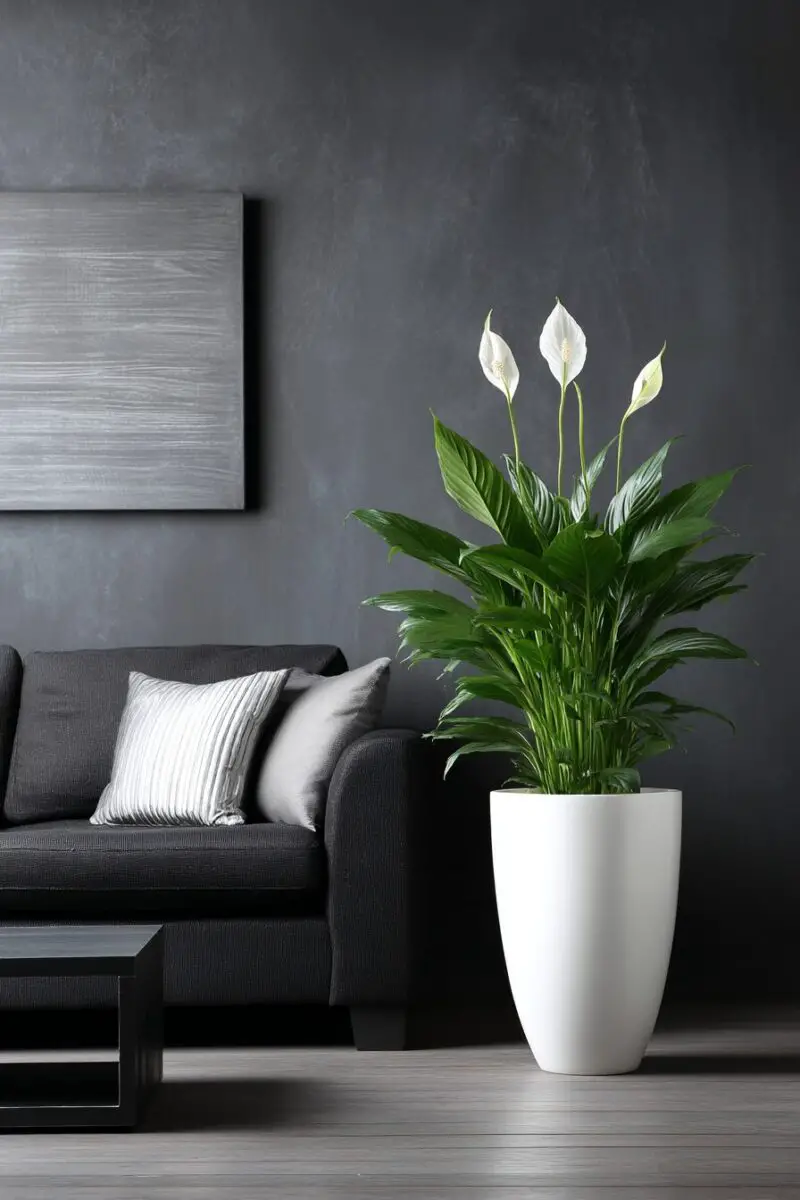
Peace Lilies stand out as rare beauties that produce stunning white flowers even in low-light conditions where most flowering plants would fail.
These elegant plants feature glossy deep green leaves that create a perfect backdrop for their distinctive hooded white blooms.
Native to tropical rainforests of the Americas, Peace Lilies naturally grow beneath dense canopies where little direct sunlight penetrates.
You can identify when your Peace Lily needs water by its dramatic drooping—the plant will visibly “faint” but quickly perk up after watering.
The plant’s white “flowers” are actually modified leaves called spathes that surround the true tiny flowers on the central spadix.
Peace Lilies bloom most abundantly in brighter locations, but they’ll still produce occasional flowers in quite dark conditions.
These plants are workhorses for air purification, effectively removing toxins like ammonia, benzene, formaldehyde, and trichloroethylene.
NASA’s Clean Air Study ranked Peace Lilies among the top indoor plants for removing harmful VOCs (volatile organic compounds) from the air.
Peace Lilies prefer consistently moist soil but not soggy conditions—watering when the top inch feels dry usually works perfectly.
These plants love humidity, making them excellent choices for dark bathrooms where shower steam provides the moisture they crave.
Peace Lilies can reach 1-6 feet tall depending on the variety, with compact options perfect for dark tabletops and larger specimens for floor placement.
The plant’s graceful arching form creates an elegant silhouette even when not in bloom, adding visual interest to dark corners.
Peace Lilies communicate clearly when they’re unhappy—brown leaf tips often indicate too little humidity, while yellow leaves suggest overwatering.
These plants can live for years with proper care, becoming more impressive and producing more blooms as they mature.
Unlike many flowering plants, Peace Lilies don’t require deadheading—their blooms naturally fade from white to green and can be left in place.
Peace Lilies are considered symbols of peace, purity, and healing in many cultures, making them meaningful gifts for dark spaces.
These adaptable plants can thrive under fluorescent lights alone, making them perfect for windowless offices, bathrooms, or interior hallways.
The contrast between dark green foliage and bright white flowers creates a striking visual display that stands out even in dimly lit spaces.
Peace Lilies are moderately toxic to pets and humans if ingested, so placement should be considered in homes with curious animals or small children.
With minimal care requirements and maximum visual impact, Peace Lilies offer perhaps the best combination of beauty and resilience for dark room plant enthusiasts.
TRENDING NOW
13 Touches To Elevate Your Home With Boho StyleChinese Evergreen
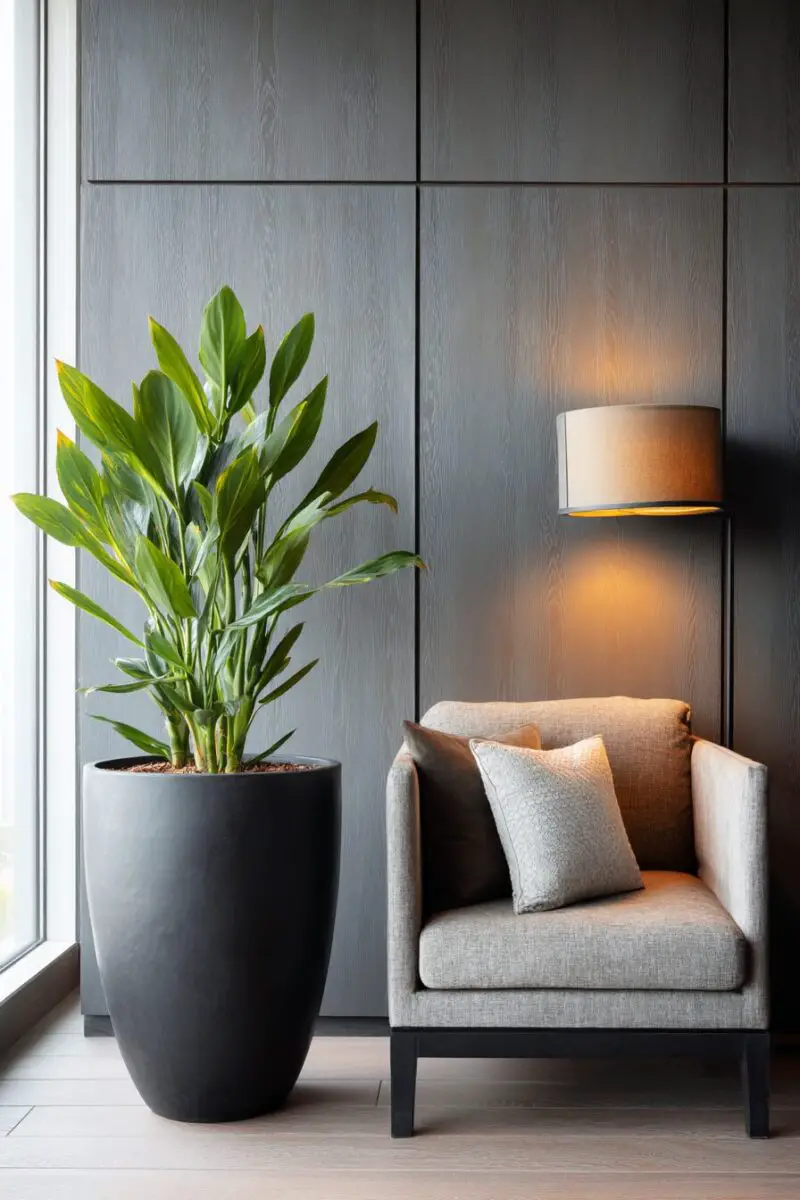
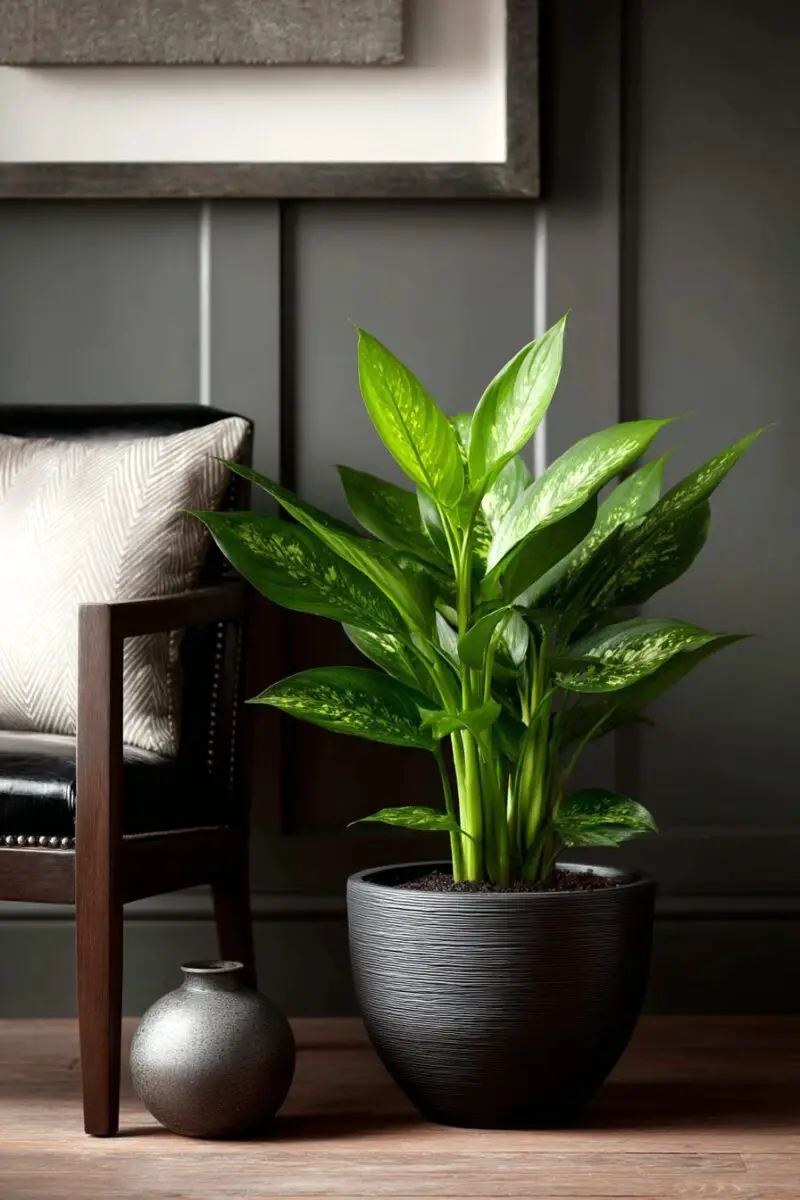
Chinese Evergreens might be the most colorful plants that can truly thrive in dark conditions, offering variegated leaves in shades of green, silver, red, and pink.
These stunning plants bring tropical vibrancy to spaces where most colorful plants would quickly fade and die.
Native to tropical and subtropical forests of Asia, Chinese Evergreens evolved to flourish in the dappled light beneath dense tree canopies.
You’ll find Chinese Evergreens in an incredible variety of patterns and colors, from the silver-splashed ‘Silver Bay’ to the pink-tinged ‘Pink Dalmatian.’
These plants grow more colorful with more light, but even in very dim conditions, they maintain their attractive variegation.
Chinese Evergreens grow slowly and compactly, reaching about 1-3 feet in height and width, making them perfect for dark tabletops or shelves.
The plant’s thick, leathery leaves store water efficiently, allowing it to tolerate occasional neglect in low-light environments.
Watering Chinese Evergreens is straightforward—allow the top inch of soil to dry out between waterings, typically every 7-10 days.
These plants prefer warm environments and will suffer if exposed to temperatures below 60°F, making them ideal for consistently heated indoor spaces.
Chinese Evergreens occasionally produce calla-like flowers followed by red berries, adding unexpected interest to dark corners.
These plants have been cultivated for thousands of years in Asia, where they’re considered symbols of good luck and prosperity.
Chinese Evergreens are exceptionally easy to care for, tolerating average room humidity and requiring little to no fertilization in low-light conditions.
The plant’s bushy growth habit creates a full, lush appearance without requiring pruning or maintenance.
Different varieties of Chinese Evergreen have different light tolerances—generally, the greener varieties can handle darker conditions than the more colorful ones.
These plants effectively remove benzene and formaldehyde from indoor air, improving the air quality in dark rooms that might not receive much ventilation.
Chinese Evergreens can be propagated through division during repotting, allowing you to multiply your collection for different dark areas of your home.
Unlike many houseplants, Chinese Evergreens rarely drop leaves or create mess, making them perfect for dark areas you don’t want to clean frequently.
The plant’s diverse color patterns allow you to coordinate with any interior design scheme, from minimalist to maximalist.
Chinese Evergreens are moderate in toxicity, so placement should be considered in homes with pets or small children.
With their combination of colorful foliage, ease of care, and tolerance for dark conditions, Chinese Evergreens offer perhaps the best visual impact-to-effort ratio of any low-light houseplant.
TRENDING NOW
Unleash Bold Style with 13 Maximalist Decor IdeasParlor Palm
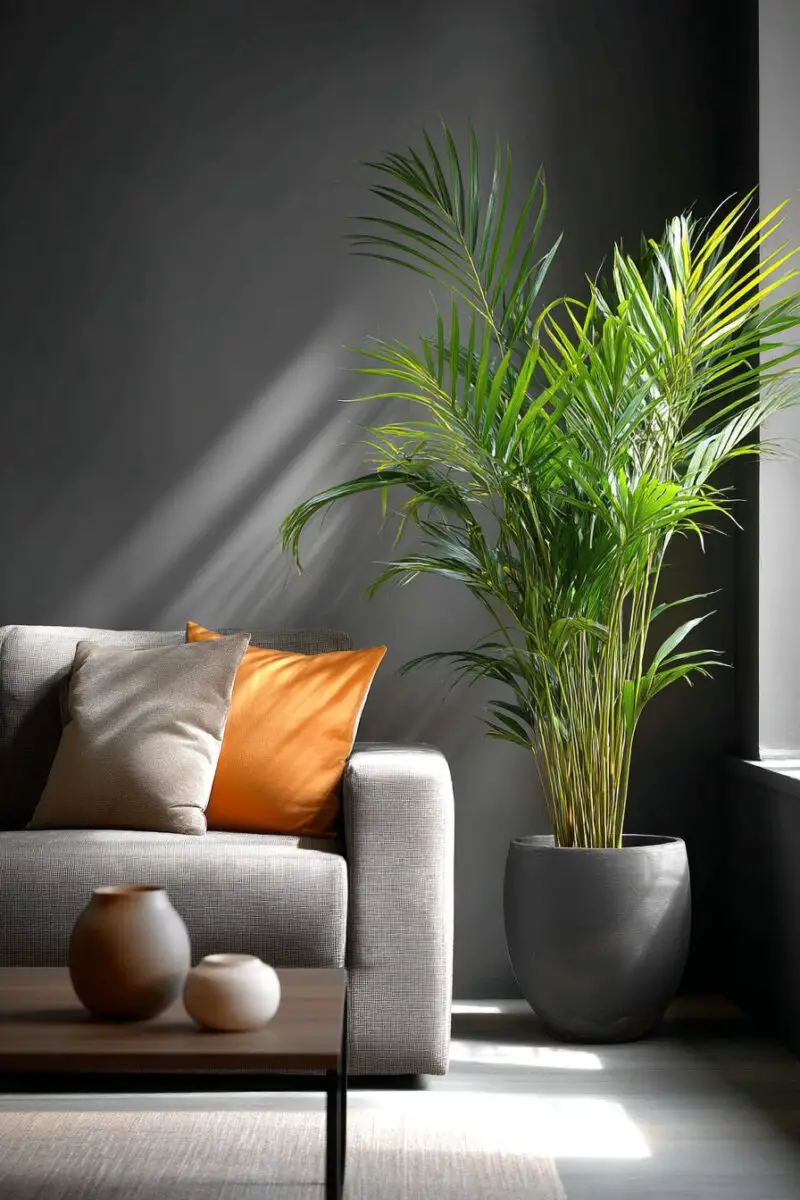
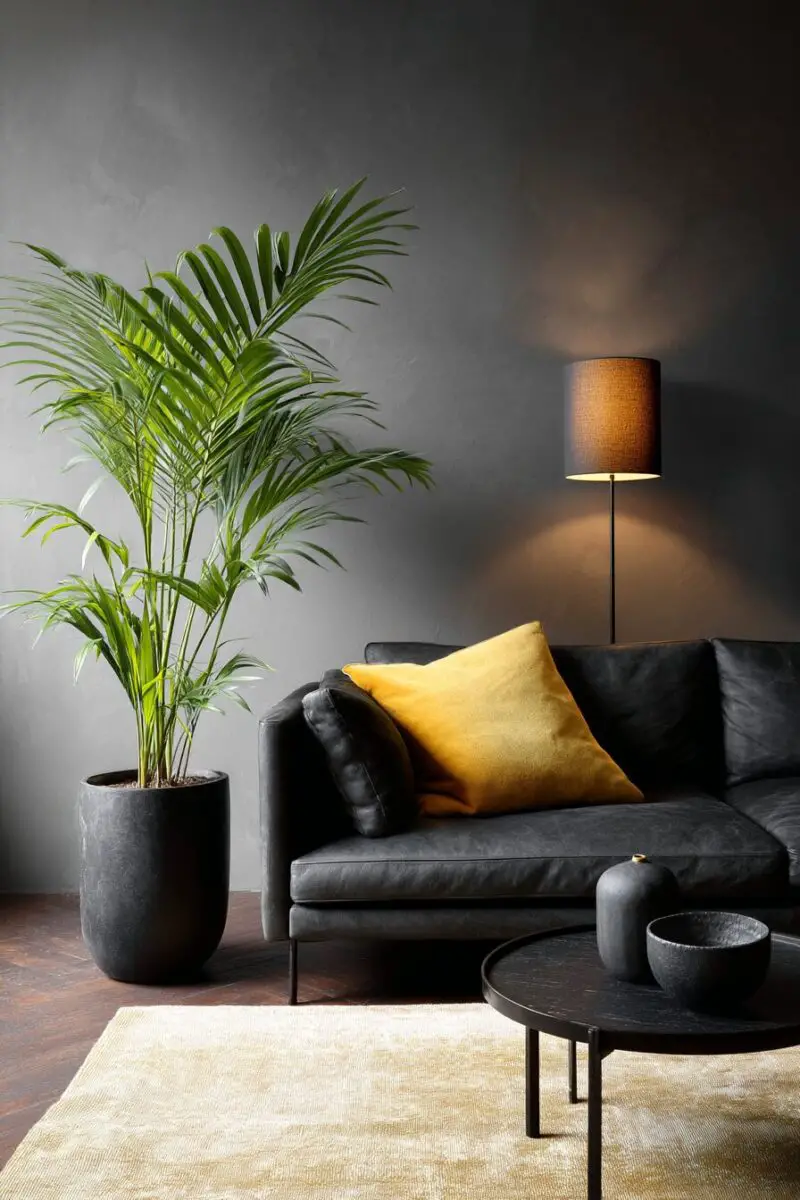
Parlor Palms have been brightening dark Victorian parlors since the 1800s, proving their remarkable ability to thrive in low-light conditions for generations.
These delicate-looking yet surprisingly tough palms bring a tropical vacation vibe to even the dimmest corners of your home.
Native to the rainforests of Guatemala and Mexico, Parlor Palms naturally grow in the deep shade of the forest understory.
You can place a Parlor Palm in a north-facing window or several feet away from any window, and it will continue to produce new fronds.
These palms feature feathery, arching fronds that create a soft, elegant silhouette in dark spaces where few other palms would survive.
Parlor Palms grow slowly, especially in low light, typically reaching just 2-4 feet tall indoors over many years.
The plant’s compact size makes it perfect for dark corners where floor space might be limited but vertical space is available.
Watering a Parlor Palm requires restraint—they prefer to dry out slightly between waterings and are more likely to suffer from overwatering than underwatering.
These palms add textural contrast to dark rooms dominated by furniture with straight lines and hard surfaces.
Parlor Palms have a natural resistance to pests and diseases when kept in appropriate conditions, making them relatively low-maintenance.
The plant’s slender stems and delicate fronds create appealing shadows when placed near subtle ambient lighting in dark rooms.
Unlike many tropical plants, Parlor Palms tolerate dry indoor air remarkably well, though they appreciate occasional misting in heated environments.
These plants clean the air by removing toxins like benzene, formaldehyde, and carbon monoxide, improving air quality in poorly ventilated dark spaces.
Parlor Palms are among the few palms that can truly thrive indoors for their entire lifespan, sometimes living for decades in the same location.
The plant’s graceful growth pattern eliminates the need for pruning or shaping, making it truly low-maintenance for dark room environments.
Parlor Palms occasionally produce small yellow flowers on thin stems, followed by black berries—a rare but delightful surprise for plant owners.
These palms are completely non-toxic to pets and humans, making them safe choices for dark bedrooms or family rooms.
Despite their tropical appearance, Parlor Palms adapt well to average room temperatures between 65-80°F.
The plant’s deep green color provides a perfect backdrop for lighter furnishings or artwork in dark spaces.
With their rich history as Victorian favorites and continued popularity in modern interiors, Parlor Palms bring timeless elegance to even the darkest corners of contemporary homes.
Spider Plant
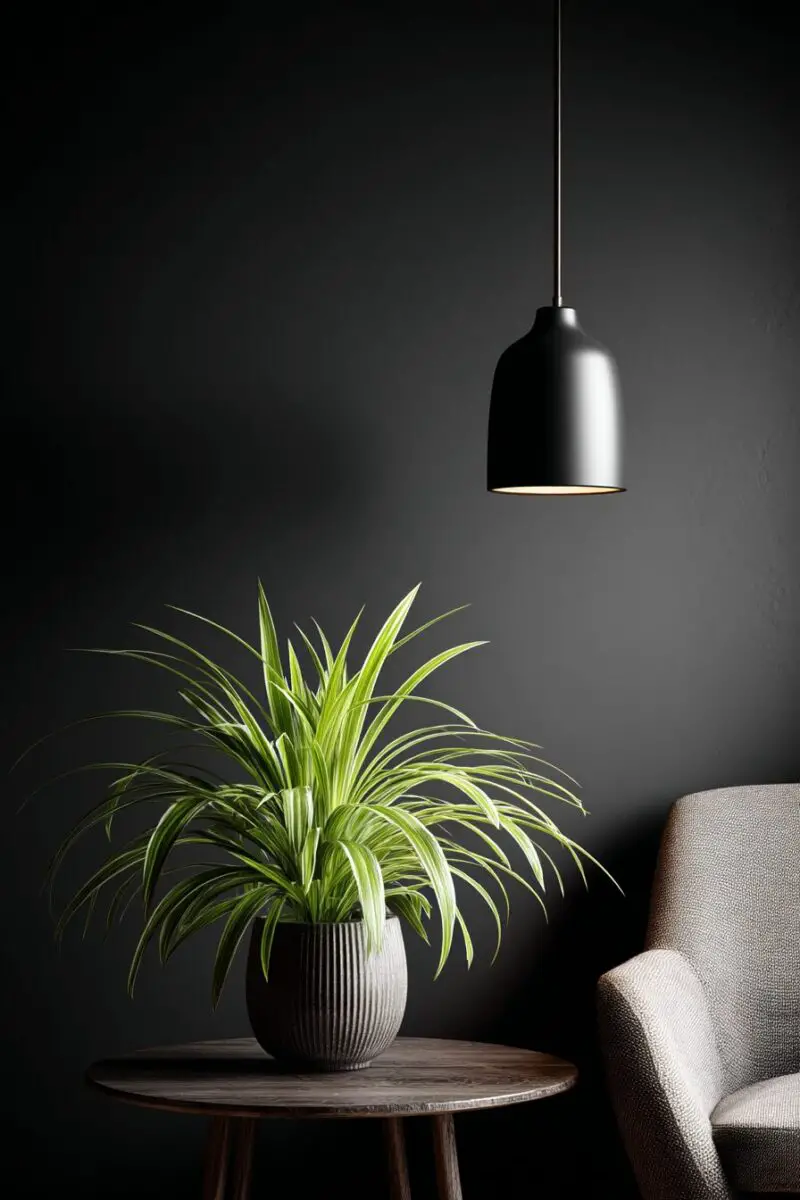
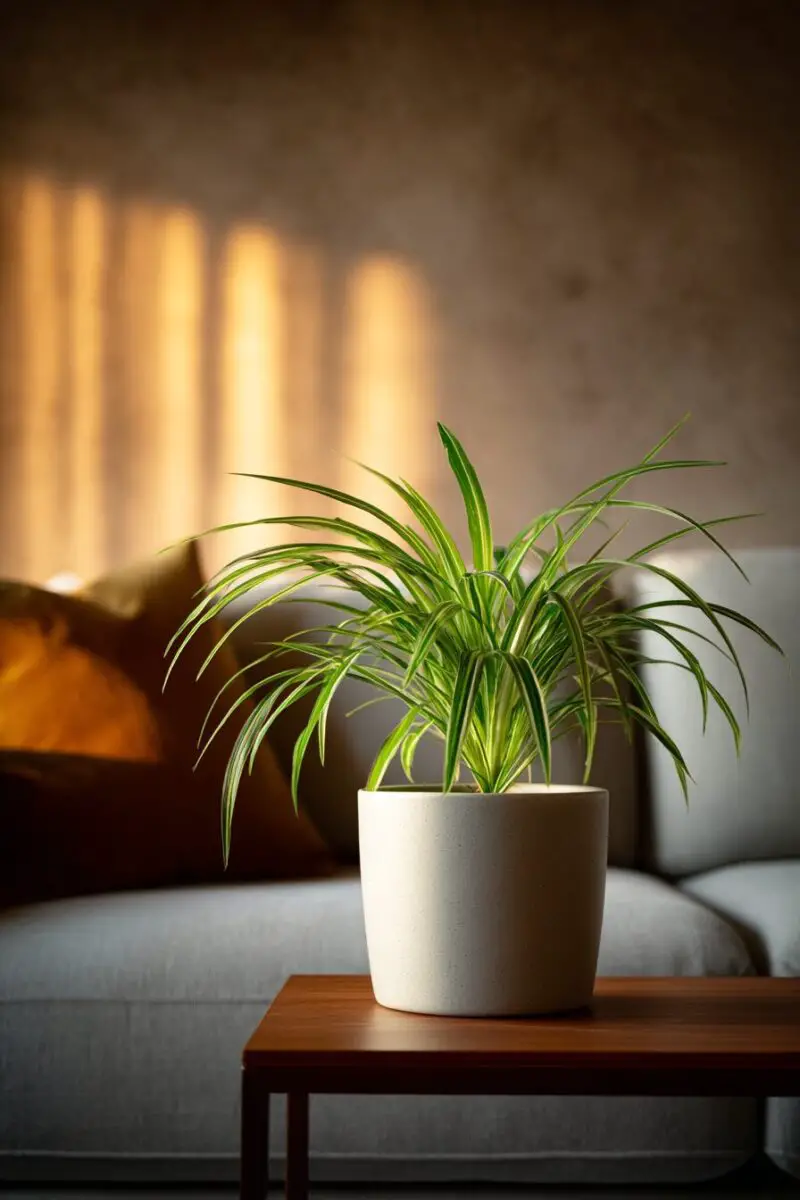
Spider Plants prove that even in dark conditions, some plants can thrive and multiply with remarkable enthusiasm.
These distinctive plants feature arching variegated leaves and produce baby “spiderettes” that dangle from long stems like spiders on a web.
Native to tropical and southern Africa, Spider Plants adapted to grow in dappled forest light, making them naturally suited to darker indoor spaces.
You’ll find Spider Plants incredibly forgiving of low light, though their signature white stripes may become less pronounced in very dim conditions.
These plants grow quickly even in suboptimal light, filling out to create a full, cascading display within months.
Spider Plants are famous for their air-purifying abilities, effectively removing formaldehyde, xylene, toluene, and carbon monoxide from indoor environments.
The NASA Clean Air Study ranked Spider Plants among the most efficient plants for improving indoor air quality.
Watering Spider Plants is straightforward—they prefer to dry out slightly between waterings, with their thick, tuberous roots storing water for drought periods.
These plants communicate clearly when they need water, with their leaf tips turning brown when chronically underwatered or overwatered.
Spider Plants produce long stems with small white flowers that develop into baby plants, creating a dramatic cascading effect even in low light.
The baby plants can be left attached to create a striking display or removed and planted to start new plants for other dark areas of your home.
These plants thrive when slightly rootbound, meaning they require less frequent repotting than many other houseplants.
Spider Plants come in several varieties, including the classic ‘Vittatum’ with white-edged leaves and ‘Bonnie’ with curly, twisted foliage for added visual interest.
Their arching growth habit makes them perfect for dark shelves, mantels, or hanging baskets where their “babies” can dangle freely.
Despite their exotic appearance, Spider Plants are completely non-toxic to pets and humans, making them safe for homes with curious cats or children.
These plants can live for many years, becoming fuller and producing more babies with age, even in consistently dark conditions.
Spider Plants are among the few plants that genuinely seem to thrive on neglect, often doing better with less attention than with too much care.
The plant’s ability to produce offsets means you’ll never need to buy another Spider Plant—one plant can produce dozens of babies over its lifetime.
Spider Plants adapt to various humidity levels, thriving in both dry bedrooms and humid bathrooms with limited natural light.
With their combination of distinctive appearance, air-purifying benefits, and remarkable reproductive abilities, Spider Plants offer exceptional value as dark room houseplants.
Heart-Leaf Philodendron
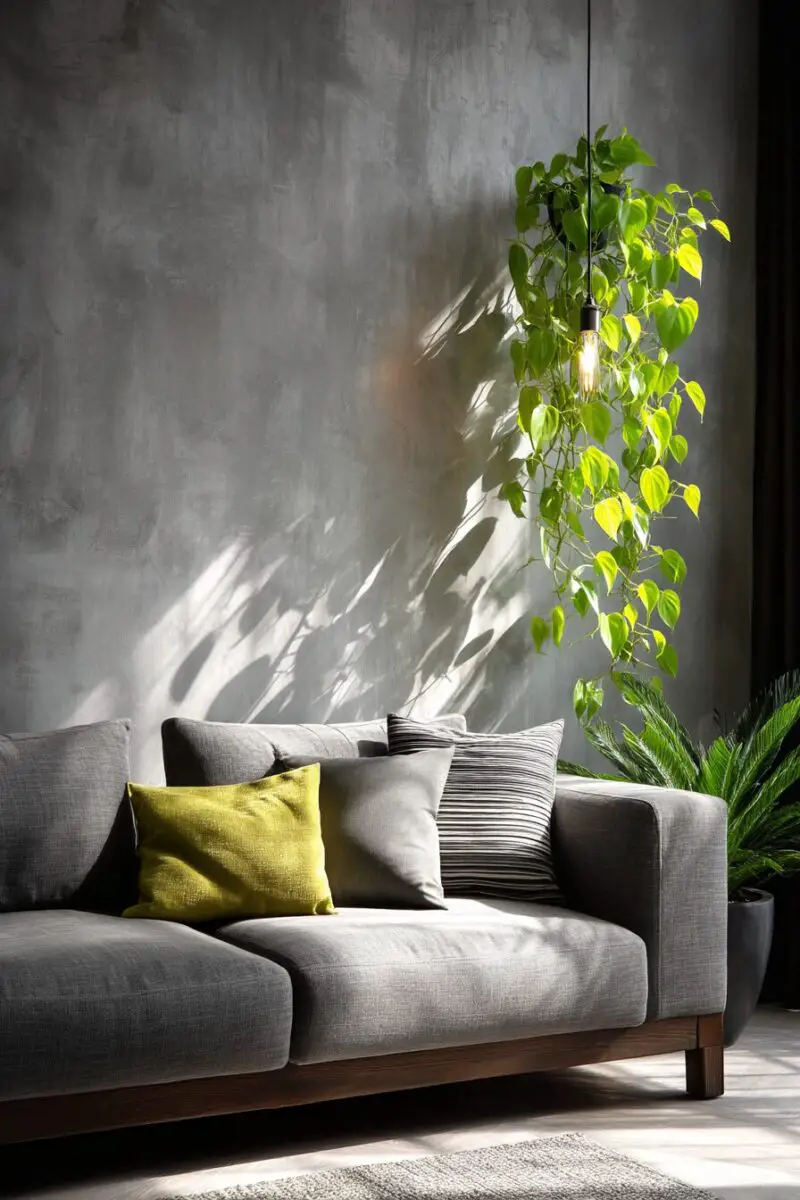
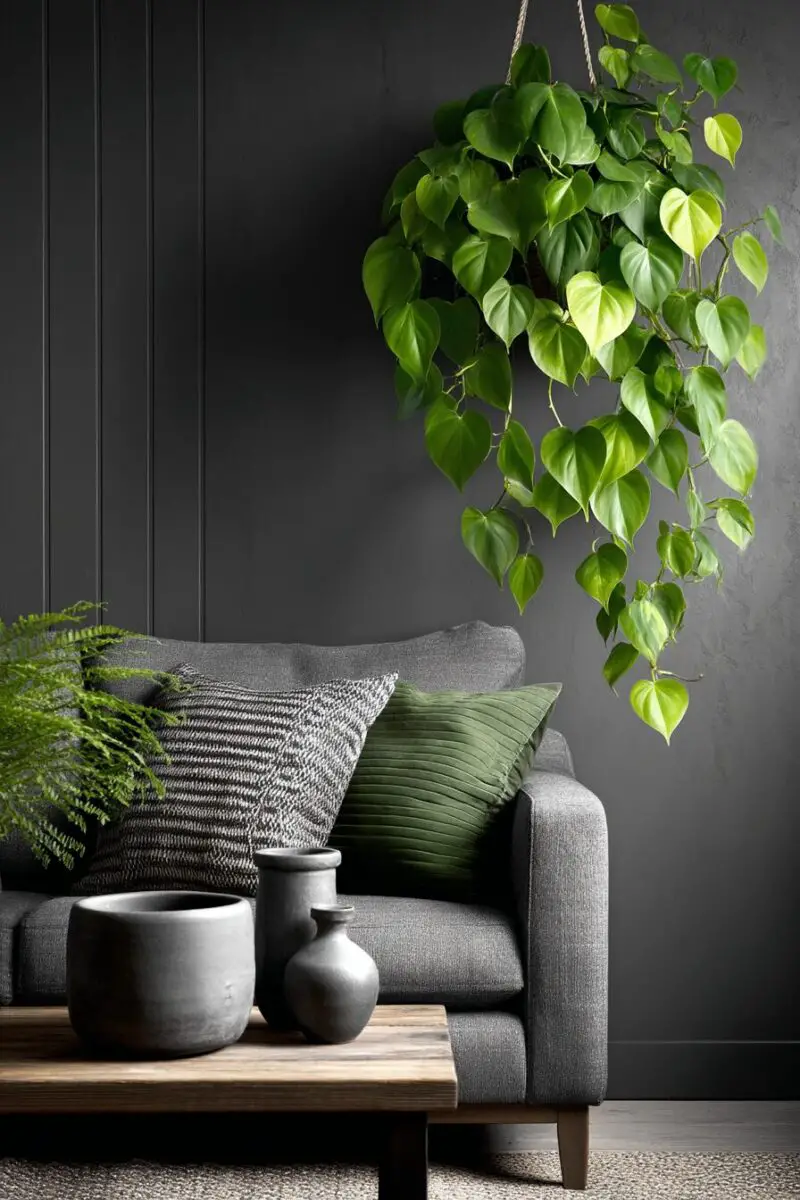
Heart-leaf Philodendrons have won the hearts of plant enthusiasts for decades with their perfectly heart-shaped leaves and incredible adaptability to dark conditions.
These tropical vines grow naturally in the dense shadows of South American rainforests, making them genetically programmed to thrive in low light.
You’ll find Heart-leaf Philodendrons remarkably forgiving of almost all care mistakes, bouncing back from underwatering, overwatering, and neglect.
The plant’s cascading vines can grow several feet long, creating dramatic drapery effects when placed on high shelves in dark rooms.
Heart-leaf Philodendrons feature glossy, deep green leaves that effectively capture what little light is available in dim spaces.
These plants grow steadily even in dark conditions, adding new leaves and length to their vines throughout the year.
Watering is simple—allow the top inch of soil to dry out between waterings, usually every 7-10 days depending on your home’s conditions.
Heart-leaf Philodendrons communicate their needs clearly—drooping leaves signal thirst, while yellowing leaves typically indicate overwatering.
The plant’s vining nature allows for creative displays in dark spaces—train them up walls with small hooks or let them cascade from shelving.
These plants effectively clean the air by removing formaldehyde and other harmful VOCs, improving air quality in poorly ventilated dark rooms.
Heart-leaf Philodendrons are incredibly easy to propagate—simply snip a section of vine with a node, place it in water, and roots will develop within days.
This easy propagation allows you to create fullness in existing plants or start new ones for other dark areas without spending additional money.
Unlike many trailing plants, Heart-leaf Philodendrons rarely drop leaves, maintaining a clean, attractive appearance with minimal maintenance.
These plants come in several varieties, including the standard green form and the rarer ‘Brasil’ with yellow variegation that brightens dark corners.
Heart-leaf Philodendrons adapt to various humidity levels but appreciate occasional misting in very dry environments.
The plant’s flexible stems can be gently wrapped around decorative objects or training wires to create living sculptures in dark spaces.
These plants grow more quickly and full when multiple rooted cuttings are planted together, creating a lush appearance even in low light.
Heart-leaf Philodendrons rarely flower indoors, focusing their energy on vegetative growth that continues even in quite dark conditions.
The plant’s moderate toxicity means placement should be considered in homes with pets or small children who might sample the leaves.
With their combination of beautiful heart-shaped leaves, incredible adaptability, and forgiving nature, Heart-leaf Philodendrons remain among the most reliable plants for transforming dark, challenging spaces.
English Ivy (Hedera helix)
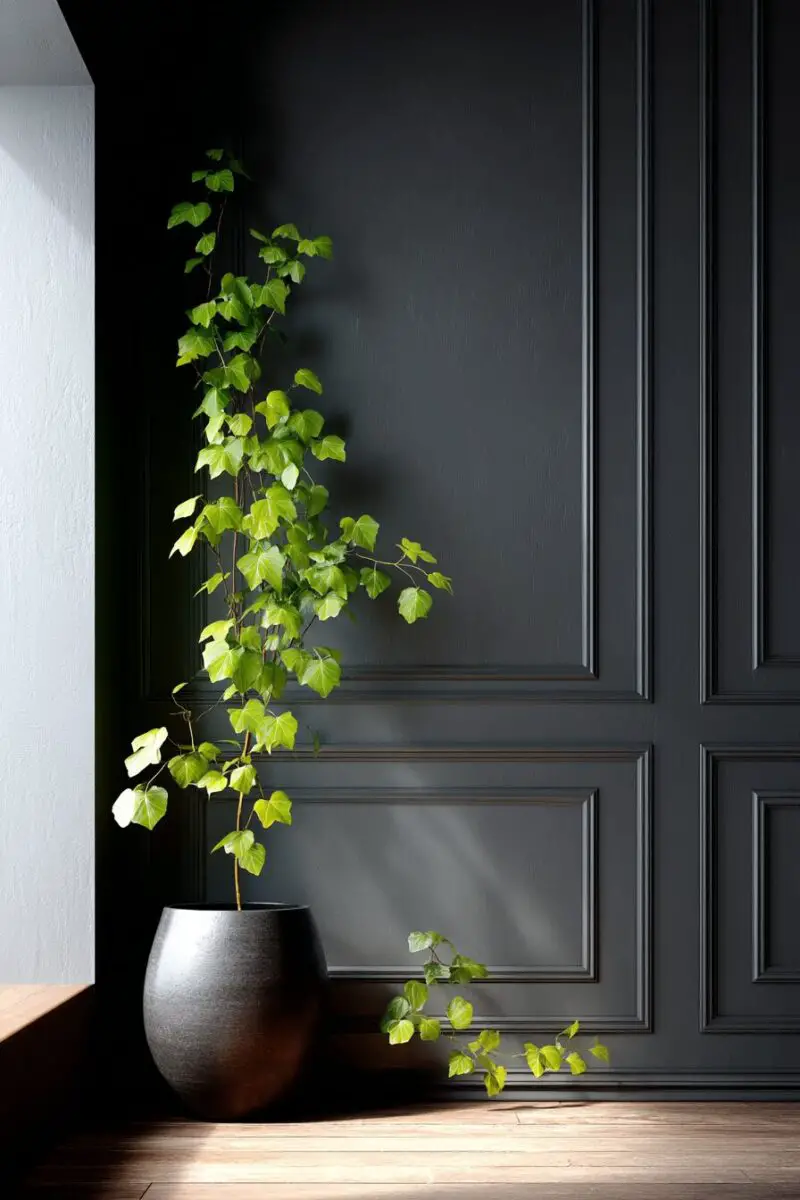

English Ivy brings a touch of old-world elegance to dark corners with its distinctive lobed leaves and adaptable growing habits.
This classic vine has decorated European castles and cottages for centuries, often growing in deep shade where few other plants could survive.
You’ll find English Ivy remarkably versatile in dark rooms—it can trail from hanging baskets, climb walls, or spread as ground cover beneath furniture.
Native to woodland environments across Europe and western Asia, English Ivy evolved to thrive in the deep shade beneath dense tree canopies.
The plant’s variegated varieties add brightness to dark corners, with options featuring cream, white, or yellow patterns against green backgrounds.
English Ivy grows steadily even in low light, though it may become leggier and produce smaller leaves than it would in brighter conditions.
These plants prefer consistently cool temperatures between 50-70°F, making them perfect for dark rooms that tend to stay cooler than sunnier spaces.
Watering English Ivy requires moderation—allow the top inch of soil to dry between waterings to prevent root rot issues.
The plant’s adaptable nature allows it to thrive in average household humidity, though it appreciates occasional misting in very dry environments.
English Ivy effectively removes airborne mold particles and fecal matter, making it an excellent choice for improving air quality in dark bathrooms.
These plants have demonstrated remarkable efficiency at removing formaldehyde from indoor air, according to NASA’s Clean Air Study.
English Ivy comes in hundreds of varieties with different leaf sizes, shapes, and variegation patterns to suit any dark room aesthetic.
The plant’s woody stems become stronger with age, allowing mature specimens to support their own weight as they climb or trail.
Smaller-leaved varieties like ‘Needlepoint’ or ‘Pixie’ create delicate textures in dark corners, while larger-leaved types make bolder statements.
English Ivy can be trained into topiary forms or onto decorative supports to create living sculptures in dark entryways or corners.
These plants are moderately toxic if ingested, so placement should be considered in homes with curious pets or children.
English Ivy grows more slowly in darker conditions, requiring less maintenance and pruning than it would in brighter locations.
The plant’s evergreen nature ensures year-round beauty in dark spaces, maintaining its attractive appearance regardless of season.
English Ivy has been used in traditional medicine for centuries, valued for its antibacterial properties and ability to reduce indoor air pollutants.
With its timeless appeal, incredible adaptability, and air-purifying benefits, English Ivy transforms dark spaces with an elegance few other plants can match.
Most of these shadow-dwellers require less frequent watering and maintenance than their sun-loving counterparts, making them perfect for busy people or beginners.
Remember that even low-light plants need some ambient light to survive—complete darkness won’t work for any plant.
Start with just one or two varieties that appeal to you, then expand your dark room jungle as your confidence grows.
These plants don’t just look beautiful—they actively improve your air quality, boost humidity, and create a more vibrant living environment.
Embrace the opportunity to transform those challenging dark spaces into stunning displays of nature’s adaptability.
Your dark rooms are waiting to be filled with life!

